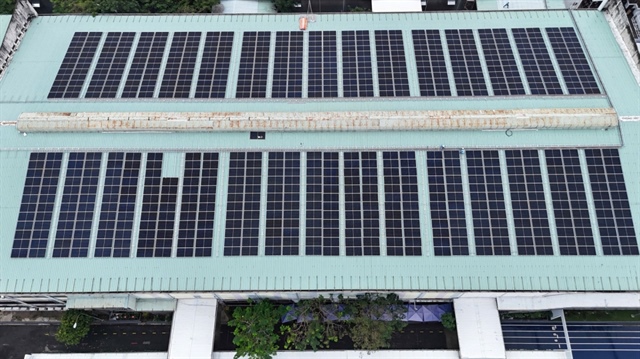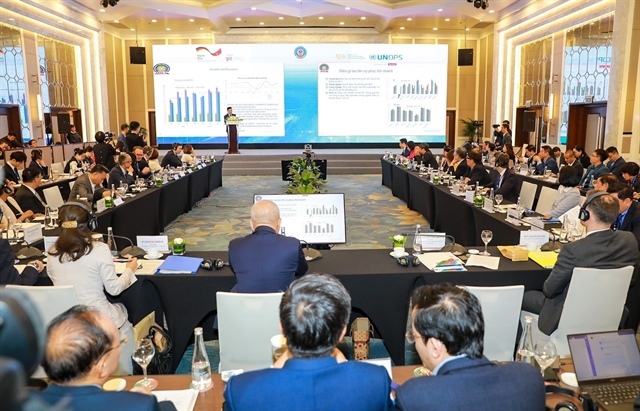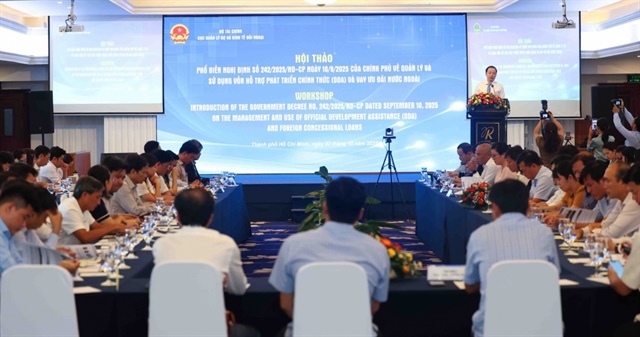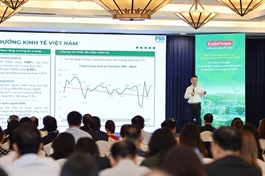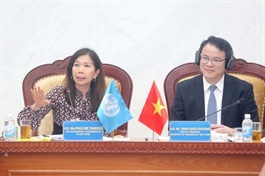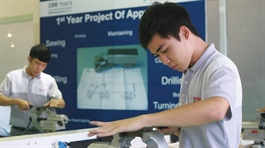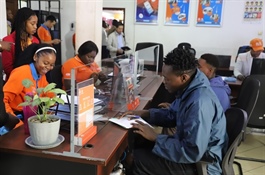The creation of an investment powerhouse
The creation of an investment powerhouse
From a nation devastated by wars, embargoes and economic isolation, the country has reinvented itself as a hub for global supply chains, drawing record levels of foreign direct investment (FDI) while fostering a vibrant domestic market.
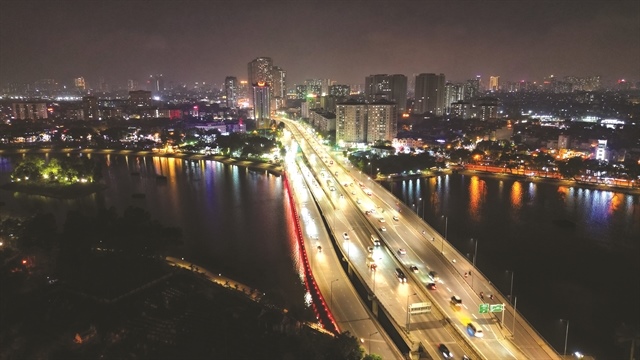
A worker operates a sock production line at a factory of Sunjin AT&C Vina, located in the Chân Mây Lăng Cô economic zone, Huế City. VNA/VNS Photo |
Eight decades after the August 1945 Revolution paved the way for national independence, Việt Nam is emerging as one of Asia’s most dynamic economies.
From a nation devastated by wars, embargoes and economic isolation, the country has reinvented itself as a hub for global supply chains, drawing record levels of foreign investment while fostering a vibrant domestic market.
According to the Foreign Investment Agency, in the first seven months of this year, total registered foreign direct investment (FDI) in Việt Nam reached over US$24 billion, up 27.3 per cent year-on-year.
Singapore was the top investor among 74 countries and territories, contributing $2.84 billion (28.3 per cent of the total). Other major investors included China ($2.27 billion) and Sweden ($1 billion).
The presence of major companies such as Samsung, LG, Intel, HSBC, Coca-Cola, Heineken, Toyota and Unilever highlights Việt Nam's appeal as a global investment destination.
Nevertheless, few companies illustrate the evolution of Việt Nam’s economic development over the past 80 years as clearly as Japan’s Marubeni Corporation, which has maintained a continual presence in Việt Nam since early on.
Marubeni, one of Japan’s leading sogo shosha (general trading and investment companies), first established operations in Việt Nam in 1941, opening offices in what is now Hồ Chí Minh City and Hà Nội.
Despite interruptions caused by war and shifting geopolitics, the company re-established its presence in 1991 and has since expanded into multiple sectors.
"More than 80 years ago when we first established a company in Việt Nam, it would be difficult to determine a certain direction," Yusaku Nemoto, general director of Marubeni Vietnam, told Việt Nam News.
"But following the philosophy of a trading company, once we find a market to stay in, we commit to transforming ourselves to adapt to the development of the local market and create new ideas."

A worker operates a sock production line at a factory of Sunjin AT&C Vina, located in the Chân Mây Lăng Cô economic zone, Huế City. VNA/VNS Photo |
Building from scratch
Việt Nam’s economic story has been anything but linear. After reunification in 1975, the country struggled with border conflicts, international embargoes and economic isolation.
Hyperinflation and shortages defined the early 1980s, leaving the government with little fiscal capacity to invest in growth. The turning point came in 1986 with the Đổi mới (Renewal) policy, which marked a decisive shift from central planning to a socialist-oriented market economy.
Those reforms unleashed private enterprise, opened the country to foreign capital and initiated a process of global integration that continues to shape Việt Nam’s development.
The results have been striking. GDP, which stood at just $8 billion in 1986, is projected to have reached nearly $476 billion in 2024.
Poverty has plummeted, falling from 58 per cent in 1993 to below 3 per cent today, while a rapidly expanding middle class is projected to account for more than a quarter of the population by 2026.
"FDI in the era of Đổi mới and integration has asserted the economic sovereignty of the country in a globalised context," said Phan Hữu Thắng, chairman of the Vietnam Industrial Park Finance Association and former head of the Foreign Investment Agency.
If the August Revolution helped Việt Nam regain national sovereignty, FDI has helped the country consolidate its position as an economic power.
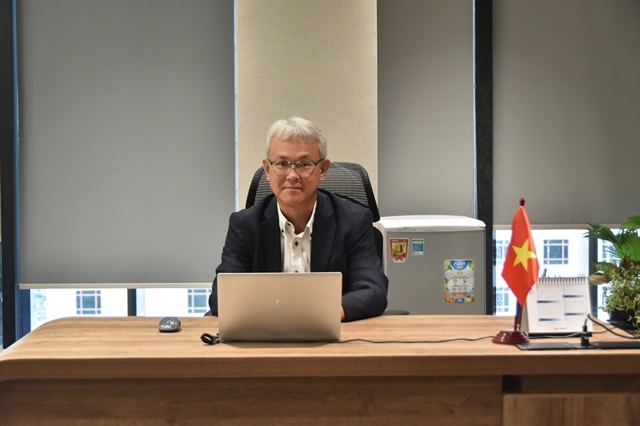
A worker operates a sock production line at a factory of Sunjin AT&C Vina, located in the Chân Mây Lăng Cô economic zone, Huế City. VNA/VNS Photo |
Marubeni’s strategic investment
Against this backdrop, Marubeni has steadily deepened its footprint. Today, the corporation operates 50 companies in Việt Nam with 7,500 employees and an annual turnover of $3 billion. Its portfolio spans three pillars: infrastructure and industrial projects, commodity trading, and mergers and acquisitions.
In the power sector, Marubeni has constructed over 5,200MW across 12 plants, beginning with the Trà Nóc thermal power plant in Cần Thơ City in 1975.
Its flagship investment, the $2.5 billion Nghi Sơn 2 coal-fired power complex, went into commercial operation in 2022. The facility, equipped with advanced technology to meet stringent environmental standards, is a cornerstone of Việt Nam’s northern power supply. It will eventually be transferred to the Government after 25 years of operation, according to Nemoto.
Marubeni has also diversified into consumer goods and manufacturing. Its 1993 investment in Acecook Vietnam helped the instant noodle producer secure a dominant share of the local market, while its 2019 establishment of Iguacu Vietnam built a modern instant coffee plant with a capacity of 16,000 tonnes annually.
More recently, it invested in Fujiya Vietnam to bring Japanese confectionery brands to Vietnamese consumers.
"We will expand our works on capturing the growth of economic and consumer power across Việt Nam and Southeast Asia," Nemoto said, highlighting the firm’s growing focus on mergers and acquisitions to support local enterprises.
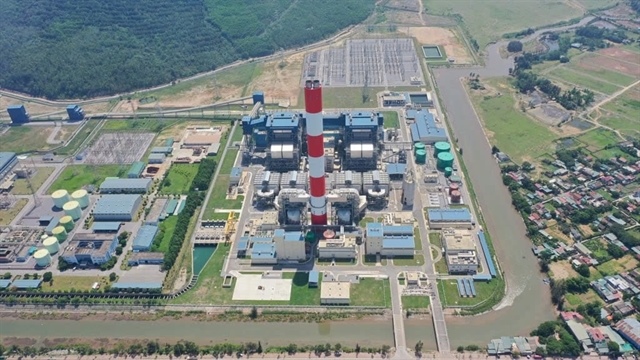
A worker operates a sock production line at a factory of Sunjin AT&C Vina, located in the Chân Mây Lăng Cô economic zone, Huế City. VNA/VNS Photo |
Competitive advantages
Việt Nam’s transformation has been underpinned by macroeconomic stability and policy reforms.
With annual GDP growth averaging 6–7 per cent in recent years, the country has become one of the fastest-growing economies in Asia.
Stable politics, transparent regulations and ongoing infrastructure investments, ranging from highways to airports and urban railways, have strengthened investor confidence.
"We appreciate the stable political system and the increasing improvement of investment conditions, which create the circumstances for us to draw up long-term plans for our work in project investment or commodities trading and to manage firm supply sources with competitive prices," said Nemoto.
"Việt Nam owns the most fruitful free trade networks in the world with more than sixty countries. This improves the competitiveness of its exports while facilitating the entrance for foreign suppliers," he added.
Still, challenges persist. To sustain growth, Marubeni’s general director suggested that Việt Nam must accelerate institutional reforms, streamline bureaucracy and enhance labour skills, especially as the country positions itself in high-tech sectors such as semiconductors, artificial intelligence and biotechnology.
Infrastructure delivery is another priority, according to Nemoto. Projects like Long Thành International Airport and the proposed North–South high-speed railway are crucial to easing logistics bottlenecks and supporting continued industrialisation.
"Looking ahead 10–20 years, Việt Nam should reinforce labour qualifications, invest in infrastructure projects and be more selective with foreign investment in line with the national development strategy," Nemoto said.
"By making these efforts, it will work for the development of Việt Nam’s economy."
- 13:38 30/08/2025


